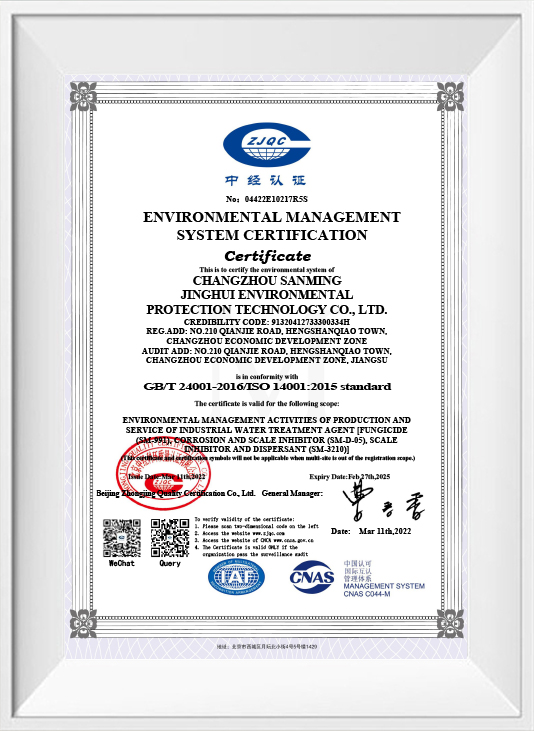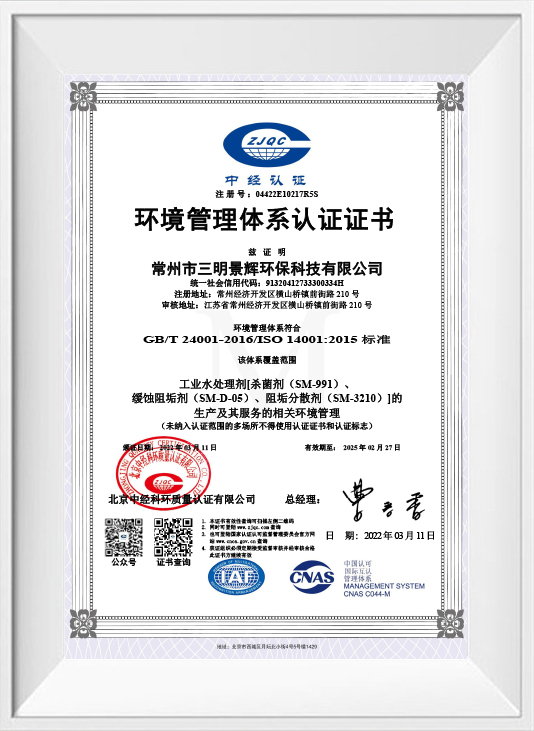1. The use of the scale inhibitor for circulating water should be combined with the water quality of the circulating cooling water system to determine the dosage, typically controlled between 8 and 20 ppm.
2. The product should be added continuously.
3. The product has good compatibility and can be used with oxidizing biocides, non-oxidizing biocides, and stripping agents.
4. The product is widely used in power generation, petrochemicals, steel, pharmaceuticals, oil and gas fields, and other industrial sectors.
-
Circulating Water Scale Inhibitor
1. The scale inhibitor for circulating water is composed of phosphorus-free polymers, dispersants, and special surfactants.
2. It has good chelation, dispersion, and lattice distortion effects on calcium carbonate, calcium sulfate, and calcium phosphate in water.
3. It is suitable for circulating cooling water systems with medium to high hardness and alkalinity, effectively controlling scale formation and ensuring the normal operation of heat exchange equipment.
4. It is suitable for circulating cooling water systems with high concentration ratios, offering significant water-saving effects.
5. The product is an environmentally friendly low-phosphorus water treatment agent that meets regional environmental discharge requirements.BENEFITS & FEATURES
Get a QuoteProduct Code SM-D-05A
Appearance Light yellow to brownish yellow transparent and homogeneous liquid
Active matter content, % ≧20.0
pH value (1% aqueous solution) 10.0~12.0
Density (20℃), g/cm3 ≧1.05
Total phosphorus content (in terms of PO43-), % ≦2.00
Since 1991
Changzhou SanmingJingHui Environmental Protection Technology Co., Ltd.
Changzhou SanmingJingHui Environmental Protection Technology Co., Ltd. (formerly Changzhou Sanming Chemical Co., Ltd.) is China Circulating Water Scale Inhibitor Suppliers and OEM/ODM Circulating Water Scale Inhibitor manufacturers, a high-tech, environmentally friendly and energy-saving water treatment agent professional enterprise integrating scientific research and development, production and sales, and technical services. It was founded in 1991.
The company is located in the central area of the Yangtze River Delta, close to the Shanghai-Nanjing Railway and the Beijing-Hangzhou Grand Canal, and is located in Hengshanqiao Town, the middle intersection of the Shanghai-Nanjing Expressway. It is only half an hour away from Changzhou Civil Aviation Airport and has convenient transportation. It has fixed assets of more than 18 million yuan, more than 20 scientific researchers, and 25% of employees have obtained various professional and technical titles.

-
What a flocculating agent actually does in a treatment train A flocculating agent is used to convert hard-to-remove fine particles (colloids), emulsified solids, and suspended matter into larger, fas...
READ MORE -
Polyaluminum chloride (often shortened to PAC) is a widely used inorganic coagulant in drinking water and wastewater treatment. If you are asking “what is polyaluminum chloride,” the most practical an...
READ MORE -
A chemical treatment establishment is a facility (or dedicated plant area) that conditions water, wastewater, or process streams using reagents such as coagulants, acids/alkalis, oxidants, or specialt...
READ MORE
More product information
Optimal Dosage and Application Techniques for Circulating Water Scale Inhibitors
Determining Optimal Dosage
The dosage of circulating water scale inhibitors is typically controlled within a range of 8 to 20 parts per million (ppm). The precise amount required depends on factors such as the hardness of the water, alkalinity, and the specific operational conditions of the cooling system.
For accurate dosage determination:
Water Quality Analysis: Regularly test the water to understand its hardness, alkalinity, and other characteristics. This helps in tailoring the inhibitor dosage to effectively manage scale formation.
System Monitoring: Continuously monitor the system for any signs of scale formation or deterioration in performance. Adjust the dosage as needed based on these observations.
Application Techniques
Continuous Addition: The scale inhibitor should be added continuously to maintain effective concentration levels throughout the system. This ensures that the inhibitor consistently interacts with the water to prevent scale formation.
Mixing and Distribution: Ensure thorough mixing and even distribution of the inhibitor within the circulating water system. This can be achieved through proper injection points and mixing mechanisms to avoid localized scaling.
Compatibility: When using additional chemicals such as biocides or stripping agents, ensure compatibility with the scale inhibitor. Many modern inhibitors, including our environmentally friendly, low-phosphorus scale inhibitor, are designed to be compatible with oxidizing and non-oxidizing biocides, enhancing overall treatment efficiency.
Advantages of Our Circulating Water Scale Inhibitor
Effective Scale Control: Provides robust chelation, dispersion, and lattice distortion effects on calcium carbonate, calcium sulfate, and calcium phosphate.
Environmental Compliance: As a low-phosphorus, environmentally friendly product, it meets stringent regional environmental discharge requirements.
High Efficiency: Ideal for systems with medium to high hardness and alkalinity, and suitable for high concentration ratios, which can lead to significant water conservation.
By adhering to these optimal dosing and application practices, you can ensure the effective management of scale formation, maximize the efficiency of your cooling systems, and achieve long-term operational savings.
 En
En
 عربى
عربى 中文简体
中文简体







